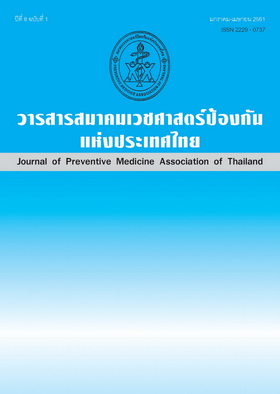Review Article: Metformin-Associated Lactic Acidosis
Abstract
Although metformin has become a drug of choice for the treatment of type 2 diabetes mellitus, a serious condition called metformin-associated lactic acidosis (MALA) can occur in patients with predisposing factors such as renal insufficiency, hepatic disease, congestive heart failure, or sepsis. The incidence of lactic acidosis in patients on metformin therapy appears to be very low, but it can be fatal when it occurs. Mortality is not correlated with lactate or metformin levels but the factors associated with fatal outcomes including
high APACHE II score, the presence of shock, the requirement for mechanical ventilation and vasopressors. Prompt recognition of lactic acidosis and early treatment using hemodialysis can result in a favorable clinical outcome, especially in patient has severe metabolic acidosis (pH< 7). To prevent MALA, risk factors should be carefully assessed and intimately monitored in renal function.
References
2. UK Prospective Diabetes Study (UKPDS) Group. Effect of intensive blood glucose control with metfromin on complications in overweight patients with type 2 diabetes (UKPDS 34). Lancet 1998 Sep 12; 352: 854-65.
3. Nathan DM, Buse JB, Davidson MB, FerranniniE, Holman RR, Sherwin R. et al. Medical management of hyperglycemia in type 2 diabetes: a consensus algorithm for the initiation and adjustment of therapy: a consensus statement of the American Diabetes Association and the European Association for the Study of Diabetes. Diabetes Care 2009 Jan; 32(1): 193-203.
4. Cryer DR, Nicholas SP, Henry DH, Mills DJ, Stadel BV. Comparative outcomes study of metformin intervention versus conventional approach the COSMIC Approach Study. Diabetes Care 2005;28(3):539-43.
5. Salpeter SR, Greyber E, Pasternak GA, Salpeter Posthumous EE. Risk of fatal and nonfatal lactic acidosis with metformin use in type 2 diabetes mellitus. Cochrane Database Syst Rev 2010 Jan 20;(1):CD002967.
6. Stang M, Wysowski DK, Butler-Jones D. Incidence of lactic acidosis in metformin users. Diabetes Care 1999 June;22(6):925-7.
7. van Berlo-van de Laar IR, Vermeij CG, Doorenbos CJ. Metformin associated lactic acidosis: incidence and clinical correlation with metformin serum concentration measure ments. J Clin Pharm Ther 2011 Jun;36(3):376-82.
8. Kirpichnikov D, McFarlane SI, Sowers JR. Metformin: an update. Ann Intern Med 2002 Jul 2;137(1):25-33.
9. Seidowsky A, Nseir S, Houdret N, Fourrier F. Metformin-associated lactic acidosis: a prognostic and therapeutic study. Crit Care Med 2009;37(7):2191-2196.
10. Emslie-Smith AM, Boyle DI, Evans JM, Sullivan F, Morris AD; DARTS/MEMO Collaboration. Contraindications to metformin therapy in patients with type 2 diabetes: a populationbased study of adherence to prescribing guidelines. Diabet Med 2001;18:483-8.
11. Gan SC, Barr J, Arieff AI, Pearl RG. Biguanide-associated lactic acidosis. Case report and review of the literature. Arch Intern Med 1992;152:2333-6.
12. Scheen AJ, Paquot N. Metformin revisited: A critical review of the benefit-risk balance in at-risk patients with type 2 diabetes. Diabetes & Metabolism2013;39:179-190.
13. Sirtori CR, Pasik C. Re-evaluation of a biguanide, metformin: mechanism of action and tolerability. Pharmacol Res 1994;30:187-228.
14. Glucophage (metformin hydrochloride) and Glucophage XR (extended-release) prescribing information. Bristol. NJ: Bristol-Myers Squibb; 2009.
15. Smith I, Kumar P, Molloy S, Rhodes A, Newman PJ, Grounds RM, Bennett ED. Baseexcess and lactate as prognostic indicators for patients admitted to intensive care. Intensive Care Med 2001 Jan; 27(1):74-83.
16. Lalau JD, Race JM. Lactic acidosis in metformin-treated patients. Prognostic value of arterial lactate levels and plasma metformin concentrations. Drug Saf 1999; Apr 20(4): 377-384.
17. Lalau JD, Race JM. Lactic acidosis in metformin therapy. Drugs 1999; 58 (Suppl 1): 55-60, discussion 75-82.
18. Sirgrun Friesecke, Peter Abel, Markus Roser, Stephan B Felix, Soeren Runge. Outcome of severe lactic acidosis associated with metformin accumulation. Critical Care 2010; 14: 226-230.
19. Lalau JD, Race JM. Metformin and lactic acidosis in diabetic humans. Diabetes Obes Metab 2000 Jun; 2(3):131-137.
20. Chih-Neng Hsu, Chung-Hao Chang, Jeng-Haw Lin, Yen-Kuang Tai. Outcome of Metforminassociated Lactic Acidosis in Type 2 Diabetic Patients.TSIM 2012; 23: 360-366.
21. Kang BI, Kim SJ, Kim JH, Gil HW, Yang JO, Lee EY, Hong SY. Two cases of metformin-induced lactic acidosis successfully treated by hemodialysis. Korean J Med 2011; 80:473-476.
22. Min Ju Kim, Ju Young Han, Jun Young Shin, Shin II Kim, Jeong Min Lee, Seongbin Hong, et al. Metformin-Associated Lactic Acidosis: Predisposing Factors and Outcome. Endocrinol Metab (Seoul) 2015 Mar;30(1):78-83.
23. Choi HS, Jung KH, Shim JJ, Chae MJ, Lee SH, Lee TW, Lim CK, Kim MJ. A case of metformin-associated lactic acidosis. Korean J Nephrol 2004;23:143-6.
Downloads
Published
How to Cite
Issue
Section
License
บทความที่ลงพิมพ์ในวารสารเวชศาสตร์ป้องกันแห่งประเทศไทย ถือเป็นผลงานวิชาการ งานวิจัย วิเคราะห์ วิจารณ์ เป็นความเห็นส่วนตัวของผู้นิพนธ์ กองบรรณาธิการไม่จำเป็นต้องเห็นด้วยเสมอไปและผู้นิพนธ์จะต้องรับผิดชอบต่อบทความของตนเอง






